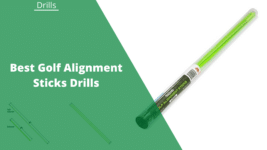Hitting a driver consistently during a round of golf is the ultimate goal of most golfers. The feeling of “crushing” a long tee shot down the fairway is hard to beat, especially if it flies past your playing partners.
From the outset, it is important to understand that the driver is the most difficult club in the bag, matched only for difficulty by a 1-iron. It has the longest shaft, 43 to 45 inches, and produces the widest swing arc. Many things can (and do!) go wrong with this club, but with practice, it can be “tamed”!
Here’s our ‘how to hit a driver consistently’ guide…
Right Equipment
It cannot be overstated how using the correct equipment will improve all-around performance throughout the player’s game. Generally, the driver will be hit 14 to 15 times from the tee during a round, and hitting it straight and long sets the hole up for a good score.
Let us get into some detail:
Shaft
The shaft is the “engine” of any club, and too often this choice sets the golfer up for failure before hitting a ball off the tee. Simply put, the shaft should be matched to the player’s swing speed to obtain the best consistent results. Most golfers err on the “too stiff” side of the choice of the shaft.
Flex
The slower the swing speed, the more flex should be used to generate clubhead speed through the ball. If matched correctly, direction, control, and distance will be achieved consistently. For the fast swinger, a stiffer shaft will not flex too much, and will also produce controlled flight and distance.
Kick-Point
The kick-point is very important and a slow swing speed should use a shaft with a “low” kick-point to get the clubhead through at impact with maximum velocity. This results in an easy, high launch, which creates distance. Conversely, the rapid swinger should use a mid to high kick-point.
Grip
The grip should also fit perfectly to the hand size, and comfort will induce confidence with the driver in hand.
Loft
For the average golfer, loft of between 10 and 10,5 degrees will get the ball airborne easily, with a good trajectory, and distance. It should be understood that the more loft on the driver, the easier it is to control.
Only proficient players should venture to a 9 or 9,5-degree driver. If playing in windy, coastal conditions, then a lower ball flight may be required, and the 9 or 9,5-degree should suffice.
Set up For the Driver on the Tee
Before getting into the stance, maybe a simple analogy will help to understand just how important the setup is. This is a Johnny Miller quote, who was a fantastic driver of the ball. “ On a shooting range with a rifle, if you do not aim at the target, how can you expect to hit it”?
Stance and Alignment
Ideally, feet should be set shoulder-width apart, and the shoulders and hips should be aligned parallel to the target line. (think of two parallel train lines) Many modern professional players stand with their feet open or closed to the target, depending on the shot shape they envisage playing. (more on this later)
Balance
Often on the golf course, the player loses his balance during the swing, and the resulting shot flies left or right of the target. At setup, it is important to feel balanced, with the weight on the “balls” of the feet. Ideally, the player should be able to “rock” onto the heels and toes before starting the swing. In fact, this can be part of a pre-swing routine. In any sport, balance plays a huge part in executing any movement correctly.
At Address
With the modern large-head drivers the ball should be pegged up high on a tee. The idea is to hit up on the ball through impact and launch the ball straight and high. Put in another way, the angle of attack should be “positive”. (Irons on the other hand should be played with a downward “negative” angle of attack.)
With this in mind, ball position is important to execute the shot correctly. Place the ball opposite the instep or just inside the right toe which ensures the point of contact is on the upswing. Professionals move the ball slightly forward to hit a fade or backward to hit a draw.
The Swing
As stated earlier, the driver has the longest shaft and therefore the longest arc. It requires the player to stand slightly further from the ball than with an iron.
Basic Fundamentals to Hit The Driver Consistently:
- Check Alignment
- Be smooth at take away
- Complete the backswing
- Do not over-swing on the backswing
- Concentrate on weight transfer
- Hit through the ball, not at it
- Maintain the swing tempo and rhythm and don’t rush it
- Think swing sequence
Check Alignment
Always check your alignment before starting the swing. Stand behind the ball and select your target on the fairway. Then look for a marker like a divot, or blade of grass within a meter and in front of the ball on the intended line. Now set your stance to this closer marker and pull the trigger on the swing. Your accuracy will improve tenfold.
Be Smooth at Take Away
Do not rush the takeaway as this initial movement makes or breaks the swing. Any jerky movement will destroy the tempo and rhythm.
Complete the Backswing
Because we all understand that this is the distance club that sets us up on the hole, the inclination is to swing faster without completing the backswing. Do not pull the club from the top as the swing sequence is broken and the ball can go anywhere.
Do Not Over-Swing on The Backswing
Try to set the club shaft at a parallel position at the top of the swing. This will give the golfer a “connected” feeling with the rest of the swing to and through the ball. Collin Marikawa pauses slightly at the top of his swing.
Concentrate on Weight Transfer
Turn the shoulders and transfer the weight from the left side to the instep of the right foot without swaying off the ball and the first movement of the downswing is to transfer the weight back to the left side. The lower body, legs, and hips, start the downswing.
Hit Through The Ball, Not at it
Concentrate on accelerating the clubhead through the ball and not at it. Finish the swing on the left side with a full follow-through.
Maintain The Swing Tempo and Rhythm and Don’t Rush it
Whatever your swing tempo is, keep it under control with the driver. Try to swing it at the same rhythm and tempo as a 7-iron. Results will astound you in terms of control and distance.
Think Swing Sequence
The swing sequence or transformation of the backswing to the downswing is the most difficult move in golf. The downswing starts with the lower body moving to the left side and the clearing or rotating of the hips. Let the shoulders and arms be passive until this sequence is in motion. They will fall into the “slot” and produce a powerful and solid strike.
These swing thoughts actually apply to every shot, other than putting. Unfortunately, with the driver, the above are the most common faults that cause golfers to hit the driver inconsistently. It is “the big stick”, and the most enjoyable to hit on the course and on the range, but do not rush the swing.
How to Hit the Driver Straight (Do you Really Want to Hit it Straight)?
Applying the above instructions will assist golfers to hit the driver straighter, with consistency. However, the straight shot at golf is also the most difficult to perform on every drive.
All golfers have a natural swing tendency and shape when striking the ball. It makes good sense to play with this shape whether it be a draw or fade. More fairways will be hit and the round will get easier and produce better scores.
When under pressure in a game, the golfer should always have a “go-to” shot which is his natural flight shape. Don’t look to hit a big hook on the final hole if you fade the ball naturally.
How to Hit a Draw or a Fade?
Basically to hit a fade or a draw with the driver requires some minor changes from the straight shot.
Fade
This is the most common natural shot among golfers, and to execute it properly, the left foot should be withdrawn slightly backward from square, which will open up the shoulders and create an out-to-in swing path.
The ball automatically moves forward in the stance. This will add a side-spin to the ball and it will move from left to right in the air. This is the best-controlled shot shape, as it lands softer and will not roll out too far on the fairway. The clubface can also be opened up from a square position at address.
Draw
To hit a draw requires the opposite movement with the stance. Move the right foot back from square and move the ball back slightly in the stance. The clubface can be closed a bit, and the swing path is now from in to out. This creates a sidespin that will move the ball from right to left in the air. The ball rolls out appreciably on the fairway and will add distance.
Play the Right Ball
To add consistency to your tee shots with the driver, the ball put into play is important. Golf balls all have different compression, and finding the correct ball will also improve accuracy and distance with the driver.
Lower compression is good for the slow swinger, whilst a faster swing speed will require a higher compression ball that will spin less. Spin can be good and bad with the driver, as too much spin will make the ball “balloon” off the tee and distance will be lost.
Conversely, too little spin on a slow swing speed will reduce the amount of time the ball spends in the air, reducing distance. Overall the majority of golfers play with a golf ball that is too hard for them to compress, and distance is lost.
Range Practice
Take the opportunity to go to the range and try out the tips given to hit the driver more consistently. Using these fundamentals as a base, slight personal adjustments should be tested to find the best results. Practice hitting a draw and a fade to improve your all-around ability to handle doglegs on the course with more confidence.
More Driver Loft/Shorten the Shaft
For senior, slow swing speed golfers or those starting out with the game, buying a driver with 11 or 12-degree loft, will make it easier to control and produce plenty of “hang time” which relates to more distance. Shortening the shaft will increase consistency, control, accuracy, and fairways hit. Ultra-light graphite shafts will increase clubhead speed.
Final Thoughts
Hitting solid drives onto the fairway during a round of golf is the key to scoring well. We all love to hit this club far, but hitting it far into the trees will cause frustration and take away the enjoyment of the day.
Take some time to practice the fundamentals and make up an “acronym” of the tips for use out on the course, and most of all enjoy the game.
Related Articles
- 6 Best Golf Drivers
- The Best Drivers for Beginners
- The 8 Best Driver Shafts
- Top Used Golf Drivers
- How To Drive a Golf Ball
Nick is the founder of GolfSpan and an avid golfer. He's not quite a pro but has over 15 years of experience playing and coaching golfers worldwide. His mission is to bring the golfing community a better experience when it comes to choosing the right golf gear and finding the right setup for your game.






